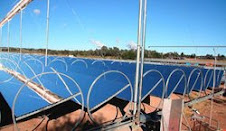from http://www.nytimes.com/2006/07/09/business/mutfund/09alter.html?_r=1&oref=slogin
By NORM ALSTER
Published: July 9, 2006
AFTER a year of stellar performance, producers of alternative energy — from ethanol to solar and wind power — took a beating in the stock market this spring.
Up more than 80 percent from May 2005 to May 8 this year, the PowerShares WilderHill Clean Energy fund, an exchange-traded fund that tracks the sector, tumbled more than 20 percent by June 30.
The sell-off unnerved the managers of some mutual funds that own alternative energy stocks. David J. Schoenwald, co-manager of the New Alternatives fund with his father, Maurice L. Schoenwald, acknowledged being fearful and uncertain of the causes or likely duration of the stock slide. "I don't know what's going on," he said. For the first six months of this year, the fund was still up 18.9 percent.
At the Winslow Green Growth fund, Matthew W. Patsky, co-manager of the portfolio with Jackson W. Robinson, said high stock prices had been the issue. "There was obviously froth in the market," he said. "You saw excessive valuations in some areas like solar." Winslow Green Growth was up 8.6 percent for the first half of the year.
Despite the spring sell-off, there were some reassuring developments for investors in alternative energy, and they came from what might seem unlikely sources. In May, Chevron announced that it was creating a business unit to research and invest in ethanol and biodiesel fuels.
"We like to form business units around key strategic objectives," said Donald L. Paul, vice president and chief technology officer at Chevron. "We're going to spend a significant amount of money in this area to get going."
In June, BP said it would spend $500 million to create a research center for biofuels. It also said it was forming a biofuels partnership with DuPont that would produce a sugar-based fuel for the British market in 2007. In November 2005, BP announced that it would invest $8 billion over the next decade in wind and solar power and in other technologies that produce electric power with lowered carbon emissions.
Chevron, Mr. Paul said, wants to find its place in the developing supply chain of biofuels, beginning with the sourcing of raw materials and extending to production, distribution and marketing. BP, a spokesman said, wants to address environmental concerns while developing longer-term supply alternatives to petroleum-based fuels.
The fact that major oil companies are scouring the field for investments could help create a floor for alternative energy share prices, said Stuart Bush, an analyst at RBC Capital Markets. For the major companies looking to hedge their bets with biofuels, "it would be easier to buy than to build capacity," Mr. Bush said. For example, Chevron announced in May that it was taking an equity position in Galveston Bay Biodiesel, which is building a plant to turn soybeans into diesel fuel.
Mr. Bush likes the prospects of a broad range of alternative energy stocks. He predicts a 35 percent increase in the next year for the WilderHill Index, a basket of 40 stocks mirrored by the PowerShares E.T.F.
Wind is "the most economically viable" alternative technology, Mr. Bush said. He favors Zoltek, which makes carbon fibers used in wind turbine blades. Blades made of carbon fibers can be longer than steel blades, allowing them to sweep a larger area and generate more electricity.
In solar power, Mr. Bush likes MEMC Electronic Materials, which supplies silicon for building solar cells. Silicon has been in short supply, and MEMC has taken advantage of the situation to lock up customers with long-term contracts at today's high prices, he said.
Though solar, wind and ethanol stocks have moved largely in concert, ethanol has been perhaps the most controversial industry sector. Ethanol is in great demand because of the high price of gasoline and because of a rush to replace MTBE, a gasoline additive intended to cut air pollution but now the subject of several lawsuits that say it contaminates groundwater.
In the United States, ethanol is generally made from corn. Those skeptical of the prospects for ethanol say that only so much farmland can be used to grow corn for fuel and that any rise in corn prices or drop in oil prices would jeopardize the profits of ethanol producers.
Elif Acar, an analyst at Standard & Poor's, said in June that most ethanol companies deserved only B-grade "speculative" ratings because of the up-and-down nature of the business.
"At its best, it could be very high margins," Ms. Acar said. "At its worst, it could be negative margins."
But while the S.& P. analysis focused on corn, Mr. Paul and other long-term ethanol investors are betting that cellulosic ethanol, derived from nonfood plant matter like grasses and farm waste, will one day be cheaper to convert into fuel. Producing cellulosic ethanol could also take far less energy than ethanol made from corn and yield considerably less pollution.
"There's big opportunities potentially in cellulosic," Mr. Paul said. Reflecting that outlook, Chevron announced last month that it would finance cellulosic research for the next five years at the Georgia Institute of Technology.
For all its promise, however, cellulosic ethanol does not offer simple investment choices. There are few publicly traded companies with cellulosic technology. Diversa of San Diego and Novozymes and Danisco of Denmark have reported progress in reducing the cost of enzymatic conversion of plant matter to fuel. Xethanol, in New York, has plans to use waste plant matter to make ethanol. Pacific Ethanol of Fresno, Calif., is one of several companies building corn-processing plants that could also make cellulosic ethanol if it could be produced at a competitive cost. But valuations on these companies are rich by most conventional measures. And because cellulosic technology is still evolving, it is difficult to identify eventual winners.
Finding any ethanol stock that is cheap is not easy, said Tim Guinness, manager of the Guinness Atkinson Alternative Energy fund. But he thinks he has one in Australian Ethanol, which is building production in Australia and the United States and is priced far more reasonably, he says, than American producers.
Investors in alternative technology stocks, Mr. Guinness asserted, must look beyond current market gyrations. "You need to take a medium-term view — at least two to four years," he said. Nobody, after all, can displace petroleum overnight.
Best Green Stocks Investing Blog
Wednesday, July 12, 2006
Subscribe to:
Post Comments (Atom)
Yuya Joe Blog
Lake Ontario Waterkeeper
The Daily Beast -Politics Blog
21stArch.com - 21st Century Architecture
Original Joe College Blog
WikiLeaks Foreign Policy Analysis
AGreenRealtor.com Real Estate Blog - Ecology Energy Efficiency
Best Green Stocks Investing Blog
PV Intell Photovoltaic Solar Stocks Investing
SEARCH Leading Alternative Energy and Ethical Investing websites

Custom Search
Daily Kos
Rare Earth Stocks Research
Patrick MacManus's Blog Peace and Collaborative Development
BeesTreesFrogsElephants.com - Nature and Ecology Blog
Research Green Energy stocks, Clean Energy investing information
Find wind power investing info online, clean energy mutual funds, geothermal stocks, solar energy investments.

Green Energy Investing Network:
Green Stocks Investing Clean Power Blog
SolarIntell.com Renewable Power Investing Website
Wind Intell.com Wind Energy Stocks Company Links
Geothermal Power Investing Public Companies
PV Intell.com Leading Photovoltaic Solar Energy Stocks

Custom Search
Green Energy Investing Network:
Green Stocks Investing Clean Power Blog
SolarIntell.com Renewable Power Investing Website
Wind Intell.com Wind Energy Stocks Company Links
Geothermal Power Investing Public Companies
PV Intell.com Leading Photovoltaic Solar Energy Stocks







No comments:
Post a Comment